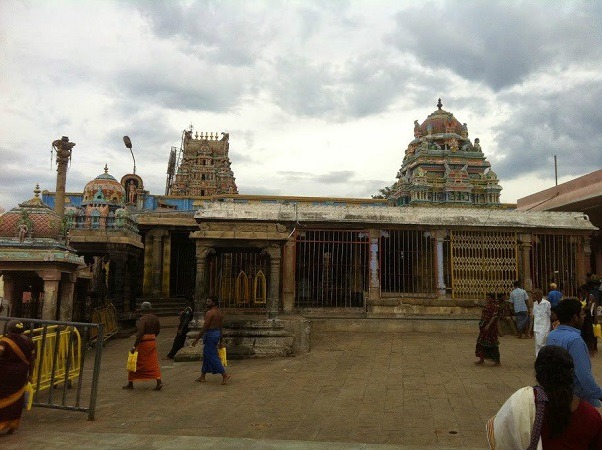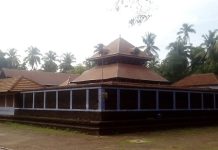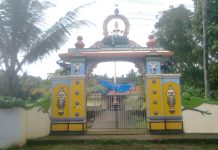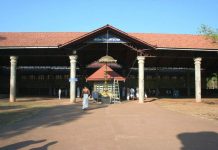Arulmigu Dhandayuthapani Swamy Temple (also known as Palani Murugan Temple), located in Palani (previously known as Thiruaavinankudi), Tamil Nadu. The temple dedicated to Lord Dhandayuthapani Swamy (Lord Murugan). It is a significant Hindu pilgrimage site and the third of the Six Abodes (also known as Arupadai Veedu) of Lord Murugan. The temple is situated in the foothills of the Palani Hills, approximately 100 kilometers southeast of Coimbatore and northwest of Madurai. The temple is considered synonymous with Panchamritam, a sweet mixture made of five ingredients.

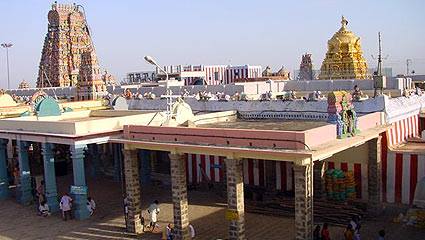
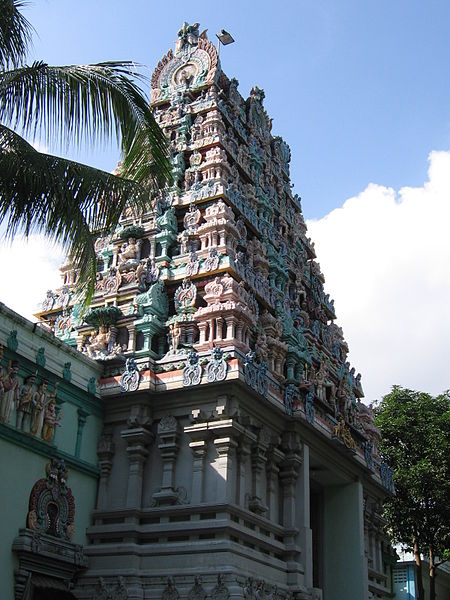
Legend of Dhandayuthapani Swamy Temple, Palani, Tamil Nadu
According to Hindu mythology, Sage Narada once visited Shiva’s celestial court at Mount Kailash and presented him with a fruit called Gnana-palam, which contained the elixir of wisdom. Shiva decided to divide the fruit between his two sons, Ganesha and Murugan, but the sage advised against cutting it. Instead, he proposed that the fruit should be awarded to whichever of the two sons first circled the world thrice. Karthikeya, mounted on his peacock, set out on his journey around the globe, while Ganesha, who believed that the world was no more than his parents Shiva and Shakti combined, simply circumambulated them. Pleased with Ganesha’s wisdom, Shiva awarded him the fruit, leaving Karthikeya furious and leading him to leave Kailash and take up residence in the Palani hills in South India.
Another legend has it that all sages and gods once gathered in Kailash, causing the earth to tilt. Shiva then asked sage Agathiyar to move to the south to balance the tilt, and Agastya employed a demon named Ettumba to carry two hills to be placed in the South. The demon carried the hills down south but found that one of them couldn’t be moved as there was a young man standing at the top of the hill. The demon tried to attack him but was defeated, and Agastya later identified the young man as Murugan and asked him to pardon the demon. Murugan did so and let the hill remain in Palani. In modern times, people carry milk on both their shoulders as a devotion to please the Lord. The demon carried the other hill to Swamimalai, which is another one of Lord Murugan’s six abodes.
History of Dhandayuthapani Swamy Temple, Palani, Tamil Nadu
According to legend, the idol of Muruga in Palani was created by sage Bogar, who was one of Hinduism’s eighteen great siddhas. He crafted it out of an amalgam of nine rocks called navapashanam, which means poison in Sanskrit. The sculptor worked rapidly to complete the features of the idol perfectly. However, some people who had access to the deity later used harmful chemicals to rob it of its contents, causing significant damage. They conspired theories that the sage did not sculpt the outer features well as he did to the face. A shrine to Bhogar, the sage, exists in the southwestern corridor of the temple, which legend says is connected to a cave in the heart of the hill where Bhogar continues to meditate with eight idols of Muruga.
After centuries of worship, the deity fell into neglect and was left to be engulfed by the forest. One night, Perumal, a king of the Chera Dynasty who controlled the area between the second and fifth centuries A.D., got separated from his hunting party and was forced to take refuge at the foot of the hill. Subrahmanyan appeared to him in a dream and ordered him to restore the idol to its former state. The king searched for the idol, found it, and constructed the temple that now houses it. He also re-instituted its worship. A small stela at the foot of the staircase that winds up the hill commemorates this event.
Dhandayuthapani Swamy Temple Architecture
The Palani Temple houses an idol of the deity Subrahmanya, made of a combination of nine poisonous substances that are believed to form an eternal medicine. The idol is placed on a stone pedestal and is framed by an archway. It represents Subrahmanya in the form of a young recluse, dressed in a loincloth and armed with a staff. The temple was re-consecrated by the Cheras and is located on the Sivagiri hill in Palani.
Access to the temple was traditionally by a staircase cut into the hill-side or by the yanai-padhai, used by ceremonial elephants. Pilgrims bearing water for the ritual bathing of the idol, and the priests, would use another way carved into the hill-side. Over time, three funicular railway tracks have been laid up the hill for convenience, supplemented by a rope-way within the past decade.
The sanctum sanctorum is of early Chera architecture and is surrounded by an ambulatory that bears traces of Pandya influence. The walls of the sanctum are covered with extensive inscriptions in the old Tamil script. A golden gopuram with numerous sculptures of Kartikeya and other deities surmounts the sanctum. The first inner prahāram has minor shrines to Shiva, Parvati, and the sage Bhogar, while the second precinct has a celebrated shrine of Ganapati and the carriage-house of Muruga’s Golden Chariot.
The temple’s priests, members of the Gurukkal community of Palani, have hereditary rights of sacerdotal worship and are the only ones allowed to approach and handle the deity. Other devotees are permitted up to the sanctum, while the priests’ assistants, normally of the Pandāram community, are allowed up to the ante-chamber of the sanctum sanctorum.
Dhandayuthapani Swamy Temple Festivals
The temple is famous for its festivals, which are celebrated with great pomp and splendor every year. These festivals include Thai-Poosam, Panguni-Uthiram, Vaikhashi-Vishakham, and Sura-Samharam. Thai-Poosam is considered the most important festival at Palani, and is celebrated on the full moon day of the Tamil month of Thai (15 January-15 February).
Devotees from all over the world come to the temple during these festivals. Before attending, they take a vow of abstinence and travel barefoot, often carrying a Kāvadi, a litter of wood, on their shoulders. The Kāvadi represents the act of the demon Hidumba, who is said to have carried the two hills of Palani on his shoulders. Some pilgrims also bring pots of sanctified water, called theertha-kāvadi, for the priests to use in the abhishekam ritual.
Dhandayuthapani Swamy Temple Timings
The temple is open from 6.00 a.m. to 8.00 p.m. on regular days, and from 4.30 a.m. on festival days. Six poojas are performed in the temple each day, including the Vilaa pooja, Siru Kall pooja, Kaala Santhi, Utchikkala Pooja, Raja Alankaram, and Iraakkaala pooja. The Golden Car, a chariot made of gold, silver, and diamonds, can be viewed at 6.30 p.m.
How to Reach Dhandayuthapani Swamy Temple, Palani, Tamil Nadu
By Air:
The nearest airport to Palani is the Coimbatore International Airport, which is approximately 100 km away. From the airport, you can hire a taxi or take a bus to reach Palani.
By Train:
The Palani Railway Station is well-connected to major cities in Tamil Nadu and other parts of the country. There are regular trains from Chennai, Madurai, Coimbatore, and other cities to Palani.
By Road:
Palani is well-connected by road to major cities in Tamil Nadu and other parts of South India. You can take a bus or hire a taxi to reach the temple town.
Once you reach Palani, the temple is easily accessible by foot, as it is located on a hill in the heart of the town. You can also take a ropeway or climb the steps to reach the temple.


























